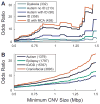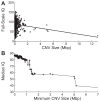The genetic variability and commonality of neurodevelopmental disease
- PMID: 22499536
- PMCID: PMC4114147
- DOI: 10.1002/ajmg.c.31327
The genetic variability and commonality of neurodevelopmental disease
Abstract
Despite detailed clinical definition and refinement of neurodevelopmental disorders and neuropsychiatric conditions, the underlying genetic etiology has proved elusive. Recent genetic studies have revealed some common themes: considerable locus heterogeneity, variable expressivity for the same mutation, and a role for multiple disruptive events in the same individual affecting genes in common pathways. Recurrent copy number variation (CNV), in particular, has emphasized the importance of either de novo or essentially private mutations creating imbalances for multiple genes. CNVs have foreshadowed a model where the distinction between milder neuropsychiatric conditions from those of severe developmental impairment may be a consequence of increased mutational burden affecting more genes.
Copyright © 2012 Wiley Periodicals, Inc.
Figures




References
-
- Awadalla P, Gauthier J, Myers RA, Casals F, Hamdan FF, Griffing AR, Cote M, Henrion E, Spiegelman D, Tarabeux J, Piton A, Yang Y, Boyko A, Bustamante C, Xiong L, Rapoport JL, Addington AM, DeLisi JL, Krebs MO, Joober R, Millet B, Fombonne E, Mottron L, Zilversmit M, Keebler J, Daoud H, Marineau C, Roy-Gagnon MH, Dubé MP, Eyre-Walker A, Drapeau P, Stone EA, Lafrenière RG, Rouleau GA. Direct measure of the de novo mutation rate in autism and schizophrenia cohorts. Am J Hum Genet. 2010;87:316–324. - PMC - PubMed
-
- Bailey JA, Gu Z, Clark RA, Reinert K, Samonte RV, Schwartz S, Adams MD, Myers EW, Li PW, Eichler EE. Recent segmental duplications in the human genome. Science. 2002;297:1003–1007. - PubMed
-
- Ballif BC, Theisen A, Coppinger J, Gowans GC, Hersh JH, Madan-Khetarpal S, Schmidt KR, Tervo R, Escobar LF, Friedrich CA, McDonald M, Campbell L, Ming JE, Zackai EH, Bejjani BA, Shaffer LG. Expanding the clinical phenotype of the 3q29 microdeletion syndrome and characterization of the reciprocal microduplication. Mol Cytogenet. 2008;1:8. - PMC - PubMed
Publication types
MeSH terms
Grants and funding
LinkOut - more resources
Full Text Sources
Medical

